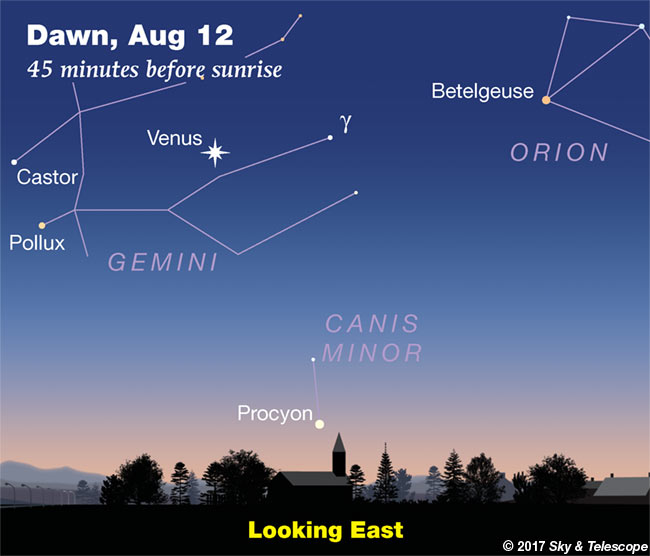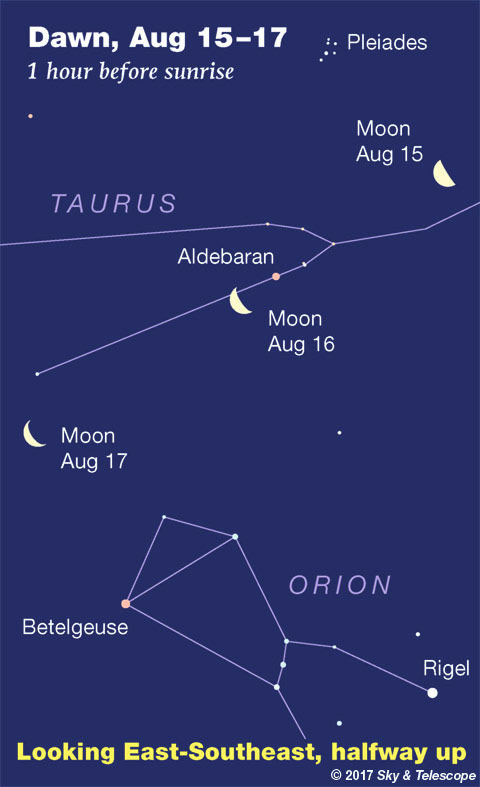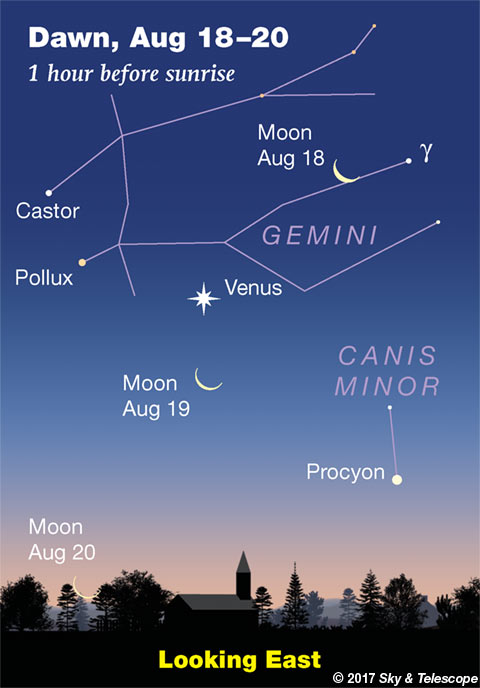
Friday, August 11
• The Perseid meteor shower, visible from the Northern Hemisphere, should be at its maximum late tonight and late Saturday night. The waning gibbous Moon will light the sky starting in mid-evening, but the brightest meteors will still shine through. You may see one every couple minutes on average, depending on the brightness and clarity of your sky. See article, The Perseids: Big Eclipse’s Opening Act.
And no, this will not be the greatest Perseid shower in history. When your well-meaning relatives forward you that viral revelation, please ask them not to make fools of themselves by believing every crazy thing on the internet. "Yes, there are ways to learn how."
Here will be all-sky-camera live streaming from the Virtual Telescope project; starts at 20:00 August 12th UT.
Live ZHR activity curve as observers around the world report their counts to the International Meteor Organization.
Saturday, August 12
• The Perseids continue tonight — and the Moon rises a little later in the evening and shines a bit less brightly. This might end up being the better night.
• The brightest star high in the southeast right after dark is Altair, with little orange Tarazed above it by a finger-width at arm's length.
A little more than a fist-width to Altair's left is delicate Delphinus, the Dolphin, leaping leftward.
Above Altair, slightly less far, is smaller, fainter Sagitta, the Arrow. It too is pointing left.
Sunday, August 13
• The Perseids are tapering down.
• Bright Vega passes closest to overhead around 10 p.m., depending on how far east or west you are in your time zone. How closely it misses your zenith depends on how far north or south you are. It passes right through your zenith if you're at latitude 39° north (Washington DC, Cincinnati, Kansas City, Lake Tahoe). How closely can you judge this just by looking?

Monday, August 14
• Last quarter Moon (exact at 9:15 p.m. EDT). The Moon rises around midnight. Once it's well up, you'll find the Pleiades to its upper left and Aldebaran a similar distance to its lower left, as shown here (for North America).
Tuesday, August 15
• In early dawn Wednesday morning the 16th, look east for the waning Moon near Aldebaran, as shown here. Below them is Orion, with his three-star belt nearly vertical.
Wednesday, August 16
• The two brightest stars of summer are Vega, overhead soon after dark, and Arcturus, shining in the west. Vega is a white-hot, type-A star 25 light-years away. Arcturus is a yellow-orange-hot, type-K giant 37 light-years distant. Their color difference is clear to the unaided eye.
Thursday, August 17
• The W of Cassiopeia, tilting a little, is nicely up in the northeast these evenings. Its upper, right-hand side is the brightest. Watch it rise higher and tilt further through the night and through the next few months.

• In early dawn Friday morning the 18th, the waning crescent Moon hangs in the east with bright Venus to its lower left, as shown here. Look left or upper left of Venus for Pollux and Castor.
Friday, August 18
• In early dawn Saturday morning the 19th, the waning Moon is under Venus low in the east, as shown here. Pollux and Castor are still to Venus's left or upper left.
Saturday, August 19
• August is prime Milky Way time, and the evening sky is now moonless. After dark, the Milky Way runs from Sagittarius in the south, up and left across Aquila and through the big Summer Triangle very high in the east, and on down through Cassiopeia to Perseus rising low in the north-northeast.
________________________
Want to become a better astronomer? Learn your way around the constellations! They're the key to locating everything fainter and deeper to hunt with binoculars or a telescope.
This is an outdoor nature hobby. For an easy-to-use constellation guide covering the whole evening sky, use the big monthly map in the center of each issue of Sky & Telescope, the essential guide to astronomy.

Once you get a telescope, to put it to good use you'll need a detailed, large-scale sky atlas (set of charts). The basic standard is the Pocket Sky Atlas (in either the original or Jumbo Edition), which shows stars to magnitude 7.6.
Next up is the larger and deeper Sky Atlas 2000.0, plotting stars to magnitude 8.5; nearly three times as many. The next up, once you know your way around, is the even larger Uranometria 2000.0 (stars to magnitude 9.75). And read how to use sky charts with a telescope.
You'll also want a good deep-sky guidebook, such as Sue French's Deep-Sky Wonders collection (which includes its own charts), Sky Atlas 2000.0 Companion by Strong and Sinnott, or the bigger Night Sky Observer's Guide by Kepple and Sanner.
Can a computerized telescope replace charts? Not for beginners, I don't think, and not on mounts and tripods that are less than top-quality mechanically (meaning heavy and expensive). And as Terence Dickinson and Alan Dyer say in their Backyard Astronomer's Guide, "A full appreciation of the universe cannot come without developing the skills to find things in the sky and understanding how the sky works. This knowledge comes only by spending time under the stars with star maps in hand."
This Week's Planet Roundup
Mercury and Mars are hidden in the glare of the Sun.
Venus (magnitude –4.0) shines brightly in the east before and during dawn, in Gemini. Look for Pollux and Castor to its left, and orange Betelgeuse much farther to its right or upper right.
Jupiter (magnitude –1.8, in Virgo) is very low in the west-southwest during twilight. Look for fainter Spica (magnitude +1.0) 6° left of it; binoculars help.
Saturn (magnitude +0.3, in the legs of Ophiuchus) glows in the south at dusk. Antares, less bright, twinkles 13° to Saturn's lower right.
Uranus (magnitude 5.8, in Pisces) and Neptune (magnitude 7.9, in Aquarius) are well up in the southeast in the hours before dawn. Finder charts.
______________________
All descriptions that relate to your horizon — including the words up, down, right, and left — are written for the world's mid-northern latitudes. Descriptions that also depend on longitude (mainly Moon positions) are for North America.
Eastern Daylight Time (EDT) is Universal Time (UT, UTC, or GMT) minus 4 hours.
______________________
"This adventure is made possible by generations of searchers strictly adhering to a simple set of rules. Test ideas by experiments and observations. Build on those ideas that pass the test. Reject the ones that fail. Follow the evidence wherever it leads, and question everything. Accept these terms, and the cosmos is yours."
— Neil deGrasse Tyson, 2014
______________________
"Objective reality exists. Facts are often determinable. Carbon dioxide warms the globe. Bacteria evolve when challenged by antibiotics. Science and critical thinking are no political conspiracy. They are how we discover reality. Civilization's survival depends on our ability, and willingness, to do so."
— Alan MacRobert, your Sky at a Glance editor
______________________
"Facts are stubborn things; and whatever may be our wishes, our inclinations, or the dictates of our passions, they cannot alter the state of facts and evidence."
— John Adams, 1770
 2
2








Comments
amirreza
August 13, 2017 at 12:58 am
So where is Saturn?
You must be logged in to post a comment.
amirreza
August 13, 2017 at 1:00 am
I couldn't wath Saturn.
You must be logged in to post a comment.
You must be logged in to post a comment.